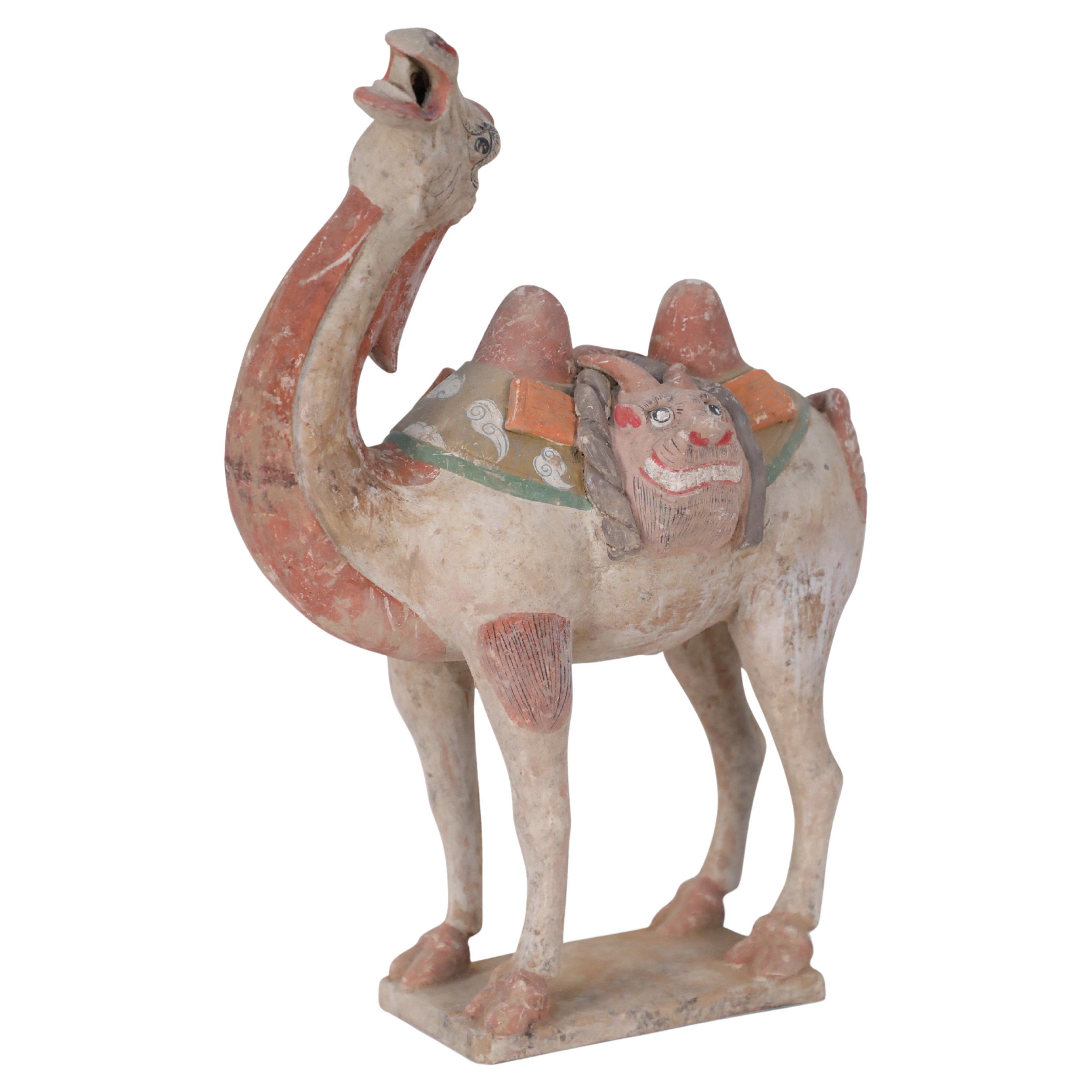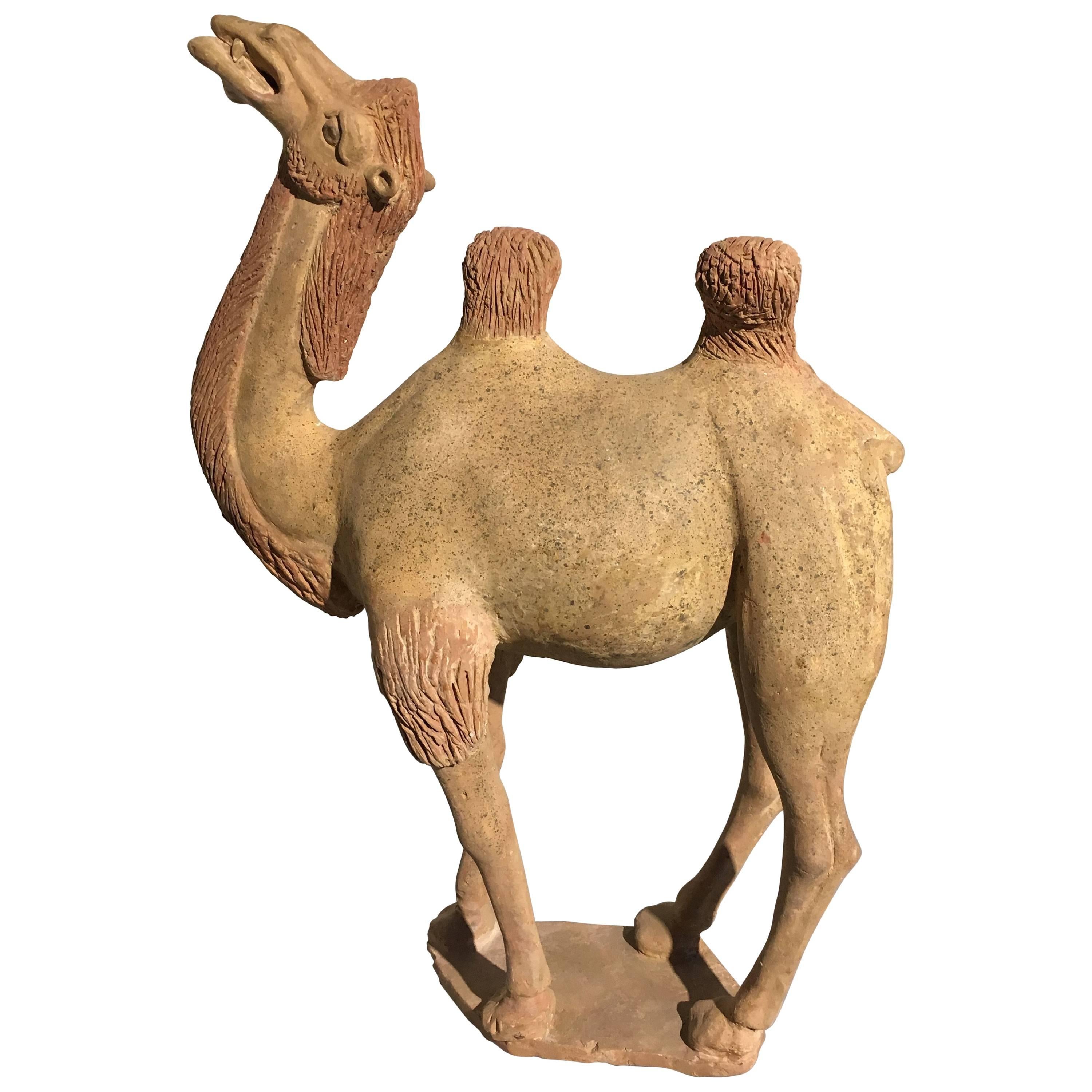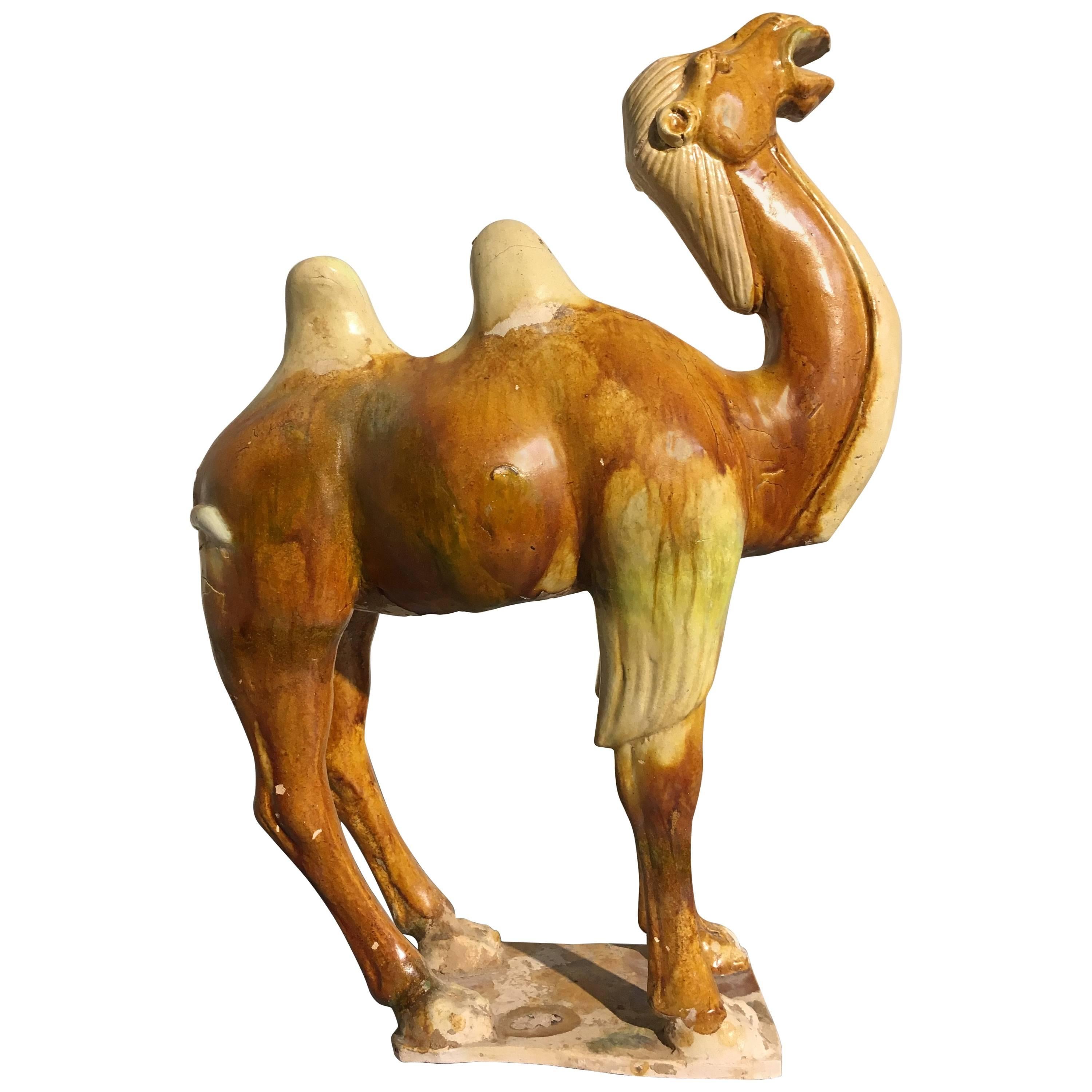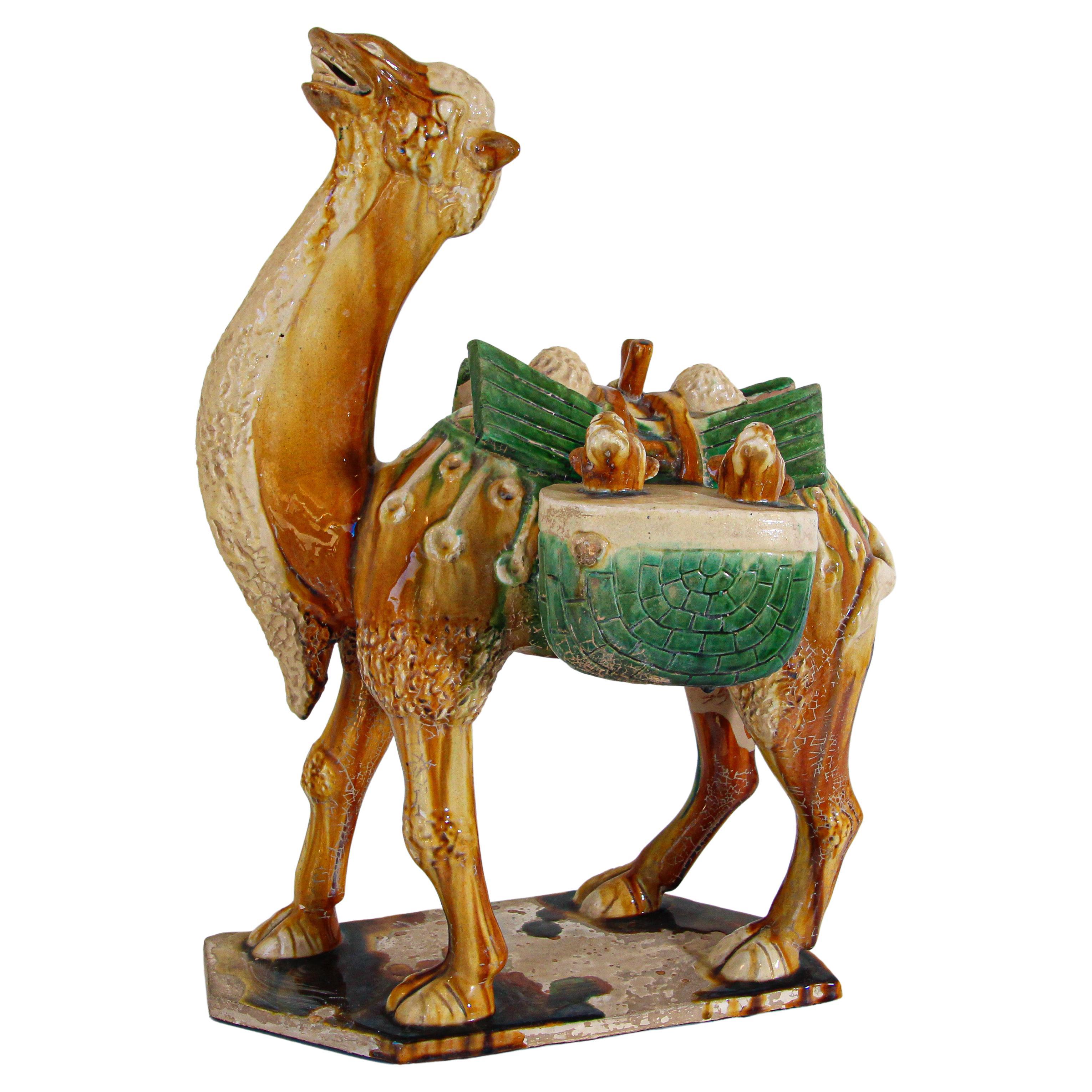Items Similar to Tang Dynasty Bactrian Camel Sculpture
Want more images or videos?
Request additional images or videos from the seller
1 of 6
Tang Dynasty Bactrian Camel Sculpture
About the Item
A recumbent Bactrian camel resting on folded legs, with remnants of white polychrome slip evident, terracotta, 618 AD to 906 AD.
Measures: Height 10 inches, width 11 inches, depth 4 inches.
Condition: Excellent. No repairs detected.
Provenance: From the Private Collection of Morton & Kathleen Sachs of Louisville, Kentucky acquired from TK Asian Antiquities (Williamsburg, VA) in 2000.
AVANTIQUES is dedicated to providing an exclusive curated collection of Fine Arts, Paintings, Bronzes, Asian treasures, Art Glass and Antiques. Our inventory represents time-tested investment quality items with everlasting decorative beauty. We look forward to your business and appreciate any reasonable offers. All of our curated items are vetted and guaranteed authentic and as described. Avantiques only deals in original antiques and never reproductions. We stand behind our treasures with a full money back return if the items are not as described.
It was during the Tang Dynasty that China’s outstanding technological and aesthetic achievements opened to external influences, resulting in the introduction of numerous new forms of self-expression, coupled with internal innovation and considerable social freedom. The T’ang dynasty also saw the birth of the printed novel, significant musical and theatrical heritage and many of China’s best-known painters and artists. The Dynasty was created on the 18th of June, 618 AD, when the Li family seized power from the last crumbling remnants of the preceding Sui Dynasty. This political and regal regime was long-lived, and lasted for almost 300 years. The imperial aspirations of the preceding periods and early Tang leaders led to unprecedented wealth, resulting in considerable socioeconomic stability, the development of trade networks and vast urbanisation for China’s exploding population (estimated at around 50 million people in the 8th century AD). The Tang rulers took cues from earlier periods, maintaining many of their administrative structures and systems intact. Even when dynastic and governmental institutions withdrew from management of the Empire towards the end of the period – their authority undermined by localised rebellions and regional governors known as jiedushi –the systems were so well- established that they continued to operate regardless.
The artworks created during this era are among China’s greatest cultural achievements. It was the greatest age for Chinese poetry and painting, and sculpture also developed (although there was a notable decline in Buddhist sculptures following repression of the faith by pro-Taoism administrations later in the regime). It is disarming to note that the eventual decline of imperial power, followed by the official end of the dynasty on the 4th of June 907, hardly affected the great artistic turnover.
During the Tang Dynasty, restrictions were placed on the number of objects that could be included in tombs, an amount determined by an individual’s social rank. In spite of the limitations, a striking variety of tomb furnishings – known as mingqi – have been excavated. Entire retinues of ceramic figures – representing warriors, animals, entertainers, musicians, guardians and every other necessary category of assistant – were buried with the dead in order to provide for the afterlife. Warriors (lokapala) were put in place to defend the dead, with domestic servants and attendants, and officials to run his estate in the hereafter. Charming examples of animals such as the current piece are perhaps the most amusing and aesthetically-pleasing of the mingqi, however. This attractive sculpture is an eloquent reminder of China’s outstanding heritage, and a beautiful addition to any serious Chinese collection.
Please also consider Avantique’s antique and ancient Asian Art Collection of Han Dynasty, Tang Dynasty, Ming Dynasty, Qing, and Republic period items to complete your home and office decorations with class. Avantiques has Asian pottery, terra cotta, bronze, and paintings to complement your collection. We strive to collect the highest quality Asian antiquities in exceptional condition.
- Dimensions:Height: 10 in (25.4 cm)Width: 11 in (27.94 cm)Depth: 4 in (10.16 cm)
- Style:Tang (Of the Period)
- Materials and Techniques:
- Place of Origin:
- Period:
- Date of Manufacture:700
- Condition:Wear consistent with age and use.
- Seller Location:Dallas, TX
- Reference Number:1stDibs: LU1774217857321
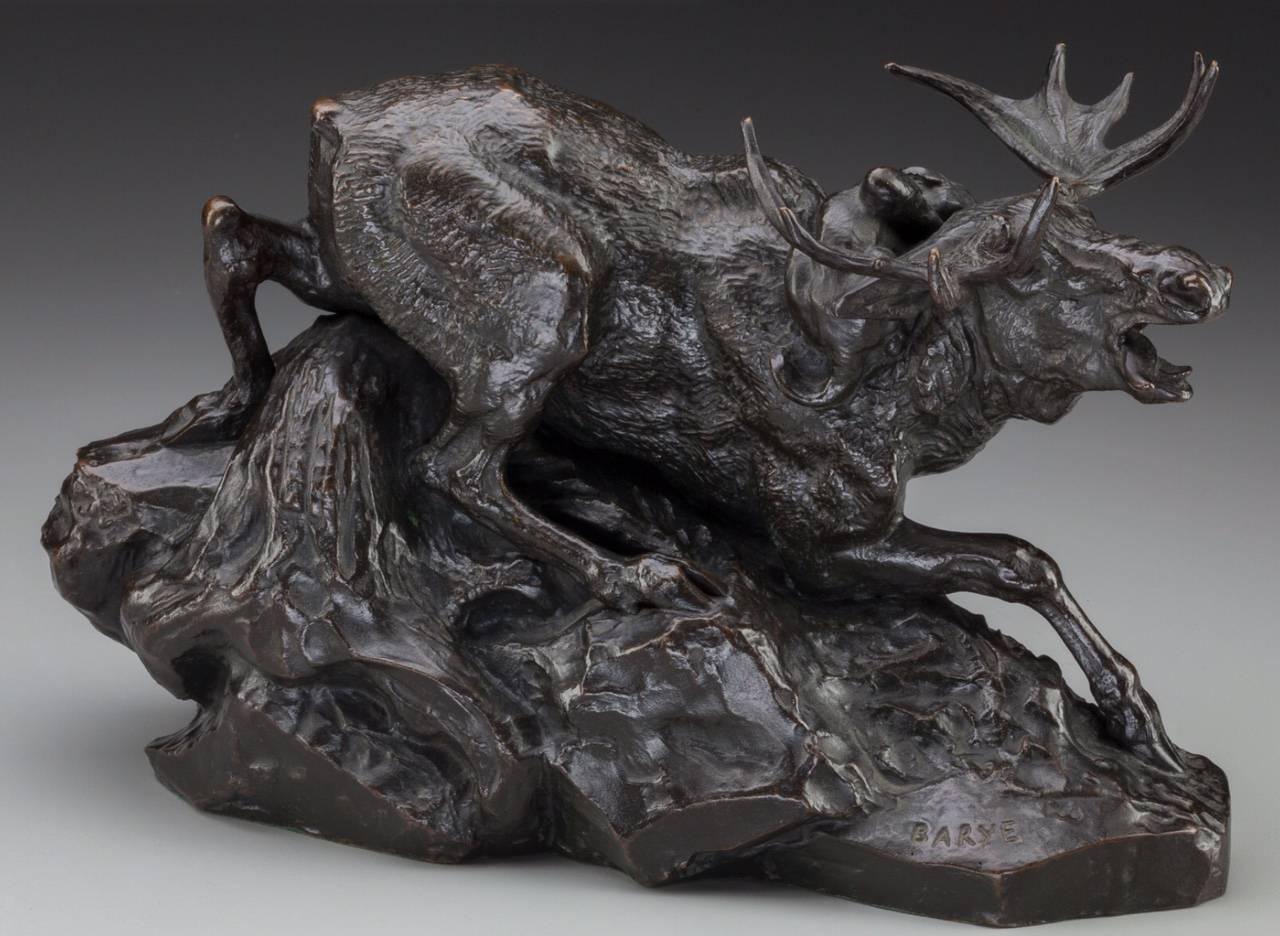
About the Seller
4.9
Gold Seller
These expertly vetted sellers are highly rated and consistently exceed customer expectations.
Established in 2000
1stDibs seller since 2015
403 sales on 1stDibs
Typical response time: 1 hour
- ShippingRetrieving quote...Ships From: Dallas , TX
- Return PolicyA return for this item may be initiated within 7 days of delivery.
More From This SellerView All
- Tang Dynasty Painted Terracotta Sculpture of a LokapalaBy Tang DynastyLocated in Dallas, TXTang Dynasty terracotta Pottery Tomb figure of the Lokapala Warrier Deity. Figure molded wearing heavy armor, standing in a dynamic pose with left arm raised in a threatening gesture...Category
Antique 15th Century and Earlier Chinese Tang Figurative Sculptures
MaterialsTerracotta
- Tang Dynasty Fat Courtesan LadyLocated in Dallas, TXTang Dynasty Painted Pottery Figure of a Fat Lady or Female Courtesan. Period (618 - 907AD) Estate / Collection: The Collection of Jay I. Kislak sold to benefit the Kislak Family Fo...Category
Antique 15th Century and Earlier Chinese Tang Figurative Sculptures
MaterialsPottery
- Tang Dynasty Fat Lady Pottery FigureLocated in Dallas, TXTang Dynasty Terracotta sculpture of a fat lady This stunning lady wears her hair in an elaborately styled coiffure. A remarkable amount of the original pigm...Category
Antique 15th Century and Earlier Chinese Tang Figurative Sculptures
MaterialsPottery
- Tang Dynasty Pottery Lokapala Tomb FigureLocated in Dallas, TXA wonderful Chinese red clay pottery tomb figure from the Tang Dynasty (618 to 907). Guarding a dignitary or decorated soldier; these figures stood guard for over a thousand years surviving to decorate your home collection of ancient artistic and cultural artifacts. Original Polychromed red and gray paint pigments still present. Chinese Buddhist guardian statues made of earthenware and pigments, from the Tang Dynasty (618–907 AD), dated to the late 7th to first half of the 9th century. The foreign facial features of this brilliantly sculpted guardian figure is evidence of the strong Western presence in Tang-dynasty China. Originating in the Lokapala deity of the Buddhist religion, which came to China from the West, this type of armored tomb guardian...Category
Antique 15th Century and Earlier Chinese Tang Figurative Sculptures
MaterialsTerracotta
- Tang Dynasty Paited Terracotta Female AttendantLocated in Dallas, TXCirca (618-907 AD) A pottery tomb attendant figure in the form of a woman who is wearing a lengthy robe with a red-painted skirt, her robes are painted ...Category
Antique 15th Century and Earlier Chinese Tang Figurative Sculptures
MaterialsTerracotta
- Tang Dynasty Pottery Horse With SaddleLocated in Dallas, TXA Tang Dynasty (618 - 907AD) Chinese Pottery Horse with Saddle. No TL test but absolutely guaranteed authentic with COA available upon request. Dimensions: 14 x 6.75 x 17 inches (35.6 x 20.3 x 43.2 cm) Condition; Very Good with wear commensurate of age and use. Invisible repairs to left ear and parts of mane and hair tuft. A super tight hairline on base of neck barely visible with magnifying glass. Strong and stable and presents beautifully. The great influence of the horse throughout the history of China cannot be underestimated. In fact, the ancient unification of the Chinese Empire was due in large part to the horse. Their rapid mobility allowed for quick communication between far away provinces. Likewise, the military role of horses aided in the conquest and submission of distant lands. The need to import stronger, faster steeds from Central Asia (as opposed to the native Mongol pony) led to the creation of the Silk Road. The importance of the horse in the history and culture of China can be viewed, in part, through the artistic legacy of this great civilization. In sculpture, painting, and literature, horses were glorified and revered, believed to be relatives of dragons, a theory reflecting their sacred status within society. During the Tang Dynasty, the adoration of the horse can be seen through their burial art. Horse models excavated from mausoleums of the period are among the most splendid and easily recognizable works of Chinese art. This work is remarkable for the amount of the original pigment that has survived the ravages of time, specifically apparent on the orange saddle. Equally impressive is the fact that the saddle has been separately crafted; it may once have supported a rider who is now lost to us. This gorgeous sculpture is a testament to the admiration and adoration the Chinese had for these marvelous creatures. Although they were an integral part in the expansion and defense of the empire, they were equally regarded for their beauty and grace as revealed by this sculpture. AVANTIQUES is dedicated to providing an exclusive curated collection of Fine Arts, Paintings, Bronzes, Asian treasures, Art Glass and Antiques. Our inventory represents time-tested investment quality items with everlasting decorative beauty. We look forward to your business and appreciate any reasonable offers. All of our curated items are vetted and guaranteed authentic and as described. Avantiques only deals in original antiques and never reproductions. We stand behind our treasures with a full money back return policy if the items are not as described. Please also consider Avantique’s antique and ancient Asian...Category
Antique 15th Century and Earlier Chinese Tang Animal Sculptures
MaterialsPottery
You May Also Like
- Chinese Tang Dynasty-Style Bactrian Camel Terra Cotta Tomb FigureLocated in New York, NYAntique Chinese Tang Dynasty-style terra cotta tomb figure of a Bactrian camel, the main form of transport over the Silk Road, with its head tilted back and mouth open to the sky, we...Category
20th Century Chinese Export Figurative Sculptures
MaterialsTerracotta
- Chinese Tang Dynasty Painted Pottery Model of a CamelLocated in Austin, TXA powerfully sculpted Chinese Tang Dynasty pottery model of a camel. The camel is portrayed in a walking stance, long neck extended, with head held high, mouth askew chewing cud. The...Category
Antique 15th Century and Earlier Chinese Tang Antiquities
MaterialsPottery
- Tang Dynasty Sancai Glazed Pottery Camel, TL TestedLocated in Austin, TXAn evocative Chinese Tang dynasty (618 to 906 AD) sancai glazed pottery model of a braying camel. The camel is well modeled, standing foursquare upon a rectangular plinth, neck raised, head thrown back, and mouth open in either a defiant, or triumphant, bray. Although sancai means "three color", this particular camel is glazed with only two colors - mostly in amber, with patches of straw glaze mimicking the large patches of fur along the camel's legs, humps, head and neck. TL tested...Category
Antique 15th Century and Earlier Chinese Tang Antiquities
MaterialsPottery
- SanCai Glazed Figure of a Camel Chinese Tang Dynasty StyleLocated in North Hollywood, CAVintage Sancai glazed blue pottery figure of a camel Chinese Tang Dynasty manner. A wonderful large Chinese Tang-style glazed pottery figure of a camel carrying goods. Made from tr...Category
Vintage 1950s Chinese Tang Sculptures and Carvings
MaterialsPottery
- Eye Catching Ceramic Horse Sculpture with Tang Dynasty LookLocated in Hopewell, NJBeautiful Tang Dynasty style ceramic horse sculpture with great detail in cream, brown and black. Gail.Category
Vintage 1980s Chinese Tang Animal Sculptures
MaterialsCeramic
- Chinese Tang Dynasty Pottery Court LadyLocated in Austin, TXPainted pottery figure of an opulent Chinese court woman with up-swept hair and standing in a simply draped robe from the Tang Dynasty (618-907 AD). Her beauty is illuminated by the ...Category
Antique 15th Century and Earlier Chinese Tang Antiquities
MaterialsPottery
Recently Viewed
View AllMore Ways To Browse
Antique Camel
Camel Antique
White Chinese Sculpture
Camel Back
Bronze Dynasty
Glass Animal Antique
Camel Decorative
Antique Bronze Sculptures Figures
Empire Bronze Sculpture
Antique Ceramic Animals
Antique Arts And Crafts Sculpture
Terracotta Dynasty
Money China
Animal Ceramic Figures
Reproduction Bronze Sculpture
18th Century Chinese Pottery
Animal Camel
Ming Dynasty Sculpture
